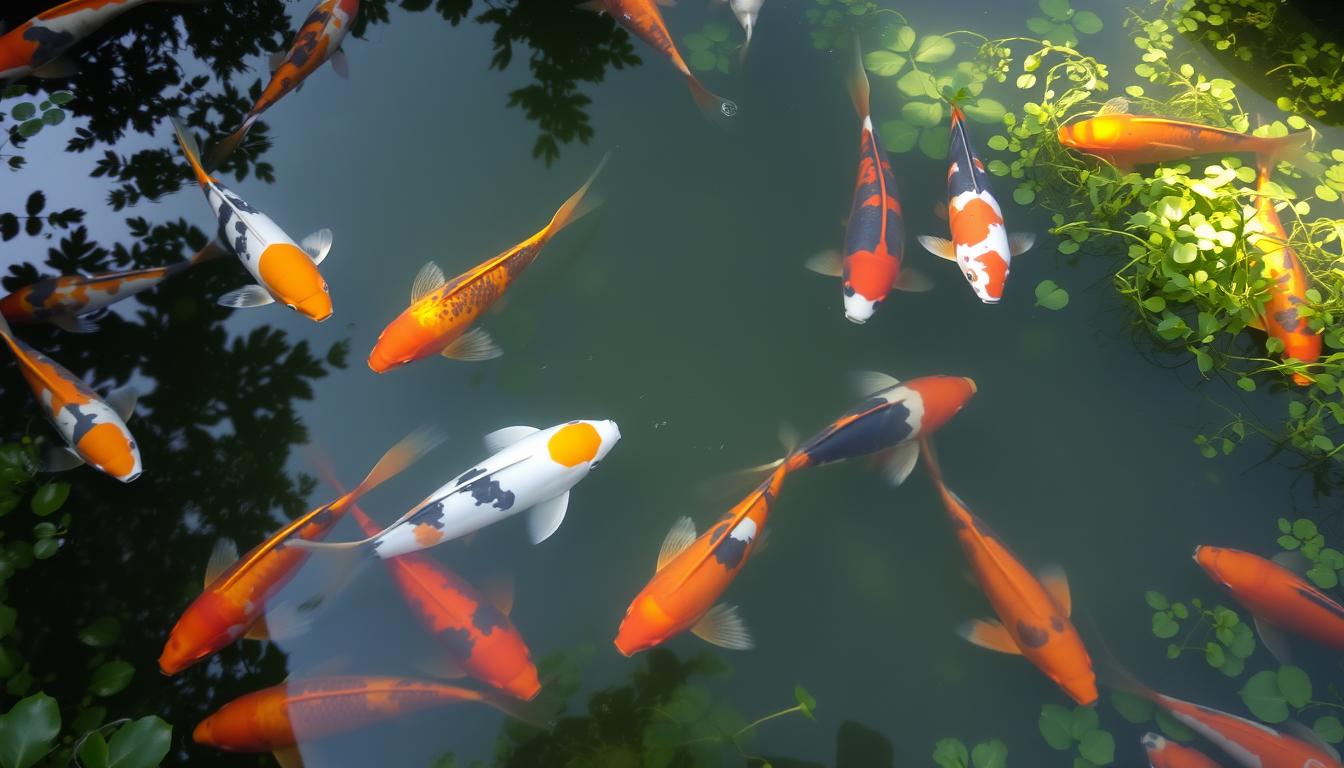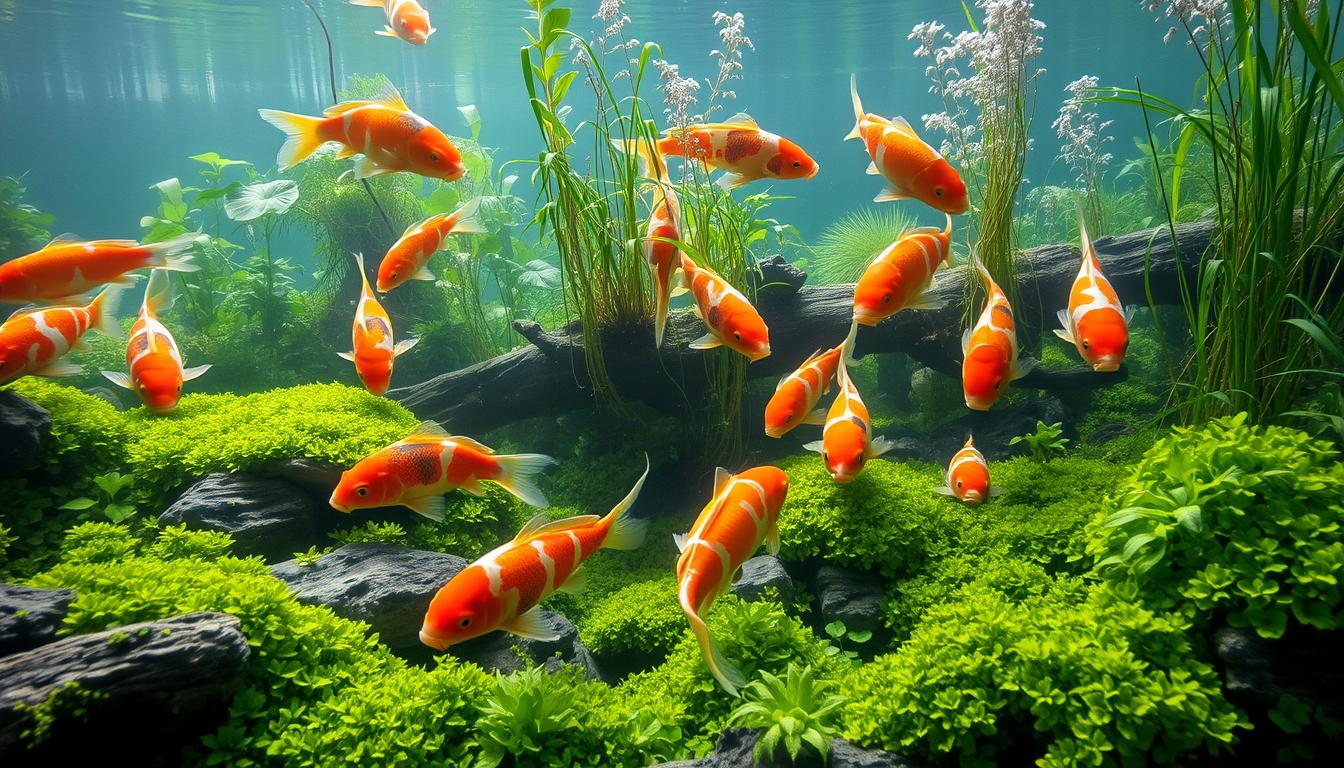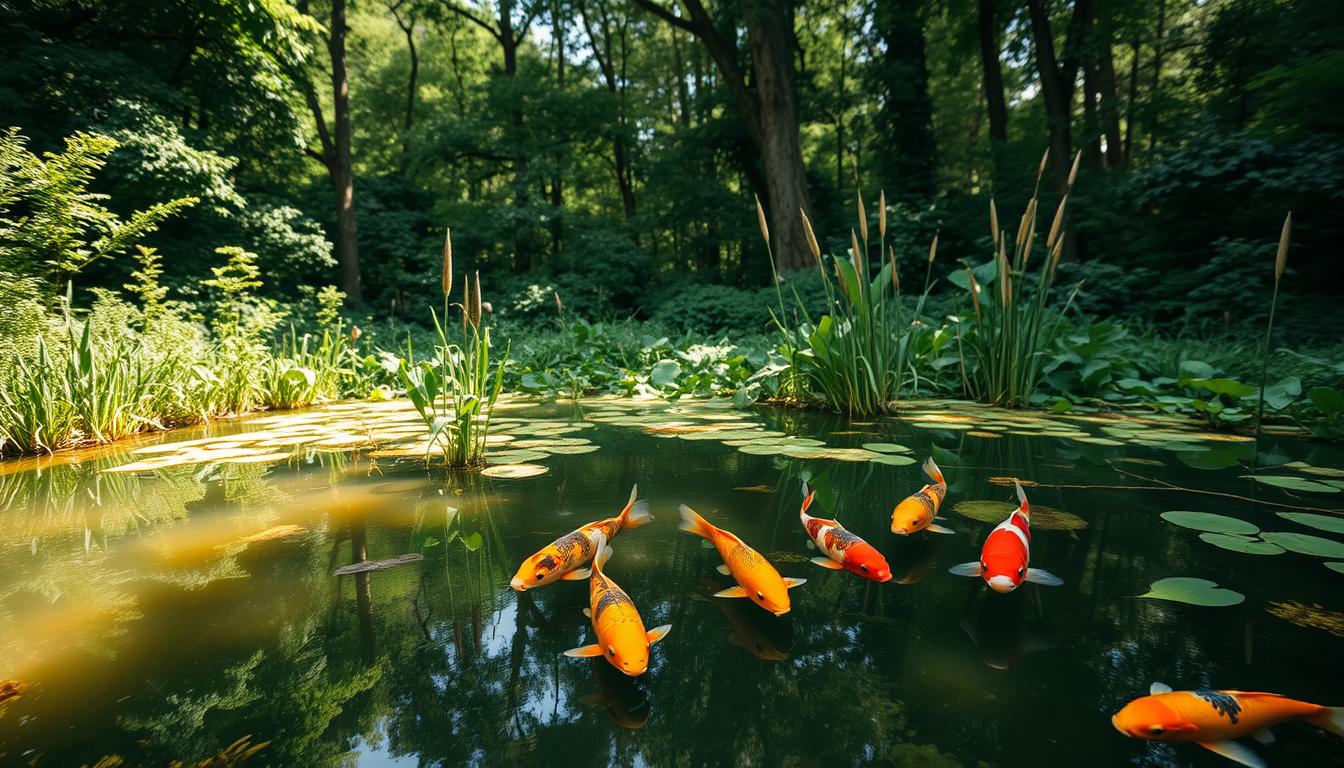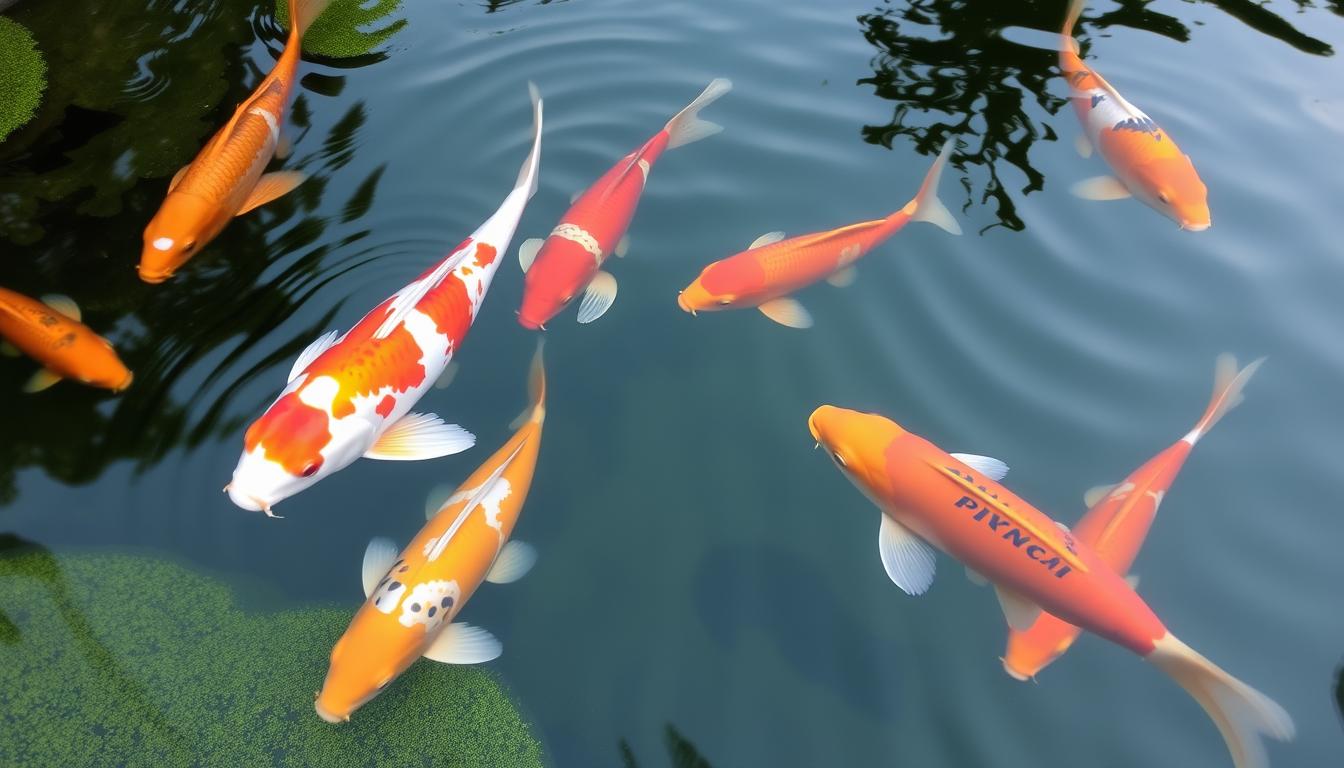Do Koi Fish Eat Algae? Understanding Their Natural Foraging Habits
This post may contain affiliate links.
Koi fish are a popular addition to outdoor ponds and water gardens, known for their vibrant colors and patterns.
Understanding their natural diet and foraging habits is crucial for maintaining their health and the overall balance of your pond ecosystem.
The relationship between koi and algae is complex, and while they may eat some algae, their role in controlling algae growth is often misunderstood.
This comprehensive guide will explore what koi naturally eat and how they interact with algae in your pond’s water.
Key Takeaways
- Koi fish have a varied diet that includes algae, but they don’t solely rely on it for nutrition.
- The effectiveness of koi as algae controllers depends on several factors, including pond size and algae type.
- Maintaining a balanced pond environment is crucial for the health of your koi.
- Alternative methods may be necessary to manage algae growth in your koi pond.
- Understanding koi foraging behavior can help you create an optimal pond environment.
The Natural Diet of Koi Fish
Koi fish are omnivores, and their natural diet consists of a variety of food sources that are essential for their vitality. In the wild, they inhabit lakes, ponds, and rivers, primarily in Japan, and their diet reflects the diverse aquatic environment.
What Koi Fish Eat in the Wild
In their natural habitat, koi fish feed on a wide range of food sources. Their diet includes algae, aquatic plants, and various protein-rich foods such as insects and larvae. Their digestive system is well-equipped to process both plant and animal matter, allowing them to thrive in different aquatic environments.
Omnivorous Nature of Koi
The omnivorous nature of koi fish gives them remarkable adaptability, enabling them to survive and flourish in various water conditions. A balanced diet that includes both plant and animal matter is crucial for their overall health, vibrant coloration, and longevity. Pond owners should respect this natural diet when feeding their koi, providing a varied diet that includes commercial koi food supplemented with natural foods to satisfy their instinctual foraging behaviors.
By understanding and respecting the natural diet of koi fish, pond owners can help ensure the health and well-being of their fish. A balanced and varied diet is key to maintaining the vibrant colors and longevity of these beautiful creatures.
Koi Fish and Algae: The Relationship
Understanding how koi fish interact with algae is crucial for maintaining a balanced pond ecosystem. While it’s common to assume that koi primarily eat algae, their relationship with algae is more complex.

Types of Algae Found in Koi Ponds
Koi ponds can harbor various types of algae, including green algae, string algae, and diatoms. These algae can grow on the pond’s surface, walls, or on decorative elements within the pond.
- Green algae often appear as a greenish tint in the water or as mats on surfaces.
- String algae, also known as filamentous algae, can form long, visible strands.
- Diatoms give the pond a brownish appearance and can coat surfaces with a brown film.
Do Koi Actually Consume Algae?
While koi fish will nibble on certain types of algae, they are not primarily algae eaters. Young koi tend to consume more algae than mature fish, but even then, algae are not their main food source.
- Koi may graze on soft, filamentous algae, but this is supplementary to their main diet.
- The amount of algae consumed by koi is generally insufficient to control excessive algae growth.
- Koi may appear to eat algae when they’re actually targeting organisms living within the algae.
By understanding the nuances of how koi interact with algae, pond owners can better manage their pond’s ecosystem.
Factors Affecting Koi Fish Foraging Behavior
The foraging behavior of koi fish is a complex process influenced by various environmental and biological factors. Understanding these factors is essential for koi pond owners to ensure their fish are healthy and thriving.
Water Temperature and Seasonal Changes
Water temperature significantly affects koi fish foraging behavior. As temperatures change with the seasons, koi adjust their feeding habits accordingly. In warmer months, koi are more active and tend to forage more frequently. Conversely, during colder months, their metabolism slows down, reducing their need to forage.
Seasonal changes also impact the availability of food sources in the pond. For instance, spring and summer often bring an abundance of insect larvae and other small organisms that koi feed on. In contrast, autumn and winter may see a decrease in these food sources, necessitating adjustments in feeding strategies by pond owners.
Pond Environment and Available Food Sources
The environment of a koi pond plays a crucial role in shaping the foraging behavior of its inhabitants. Factors such as pond size, depth, and substrate type can significantly influence how koi fish forage. For example, koi prefer to sift through fine gravel or sand rather than large rocks or bare pond liners.
- The presence of aquatic plants creates microhabitats that harbor small organisms, enhancing foraging options.
- Water clarity affects how koi locate food, relying on both sight and smell.
- Competition among pond mates can lead to more competitive feeding behaviors.
The availability of naturally occurring food sources like insect larvae, worms, and plant matter can supplement commercial feeding and encourage natural foraging behaviors. A balanced pond ecosystem that includes a variety of these food sources can promote healthy foraging habits among koi.
| Factor | Impact on Koi Foraging Behavior |
|---|---|
| Water Temperature | Influences metabolism and feeding frequency |
| Pond Size and Depth | Affects availability of natural food sources |
| Substrate Type | Determines ease of foraging for food |
The Benefits and Limitations of Koi as Algae Controllers
Understanding the benefits and limitations of koi fish as algae controllers is crucial for effective pond management. Koi fish can contribute to algae control, but their effectiveness varies depending on several factors.
How Effective Are Koi at Controlling Algae?
Koi fish can consume certain types of algae, helping to maintain a balanced ecosystem in the pond. However, their impact is limited, especially during periods of rapid algae growth.

Several factors influence the effectiveness of koi fish in controlling algae, including water temperature, pond environment, and available food sources.
When Koi Fish Aren’t Enough for Algae Management
While koi fish can be a useful component of algae management, they are often not enough on their own. Additional strategies are necessary, particularly when algae coverage exceeds 10-15% of the pond surface or water clarity decreases significantly.
- Most koi ponds require supplementary algae management strategies, especially during warm weather months.
- Ponds with inadequate filtration systems or high fish loads relative to pond volume often experience algae issues that koi cannot address.
- During algae blooms or when water quality parameters become imbalanced, systematic approaches beyond koi fish are necessary.
By understanding the benefits and limitations of koi fish as algae controllers, pond owners can develop more effective algae management strategies.
Proper Nutrition for Koi Fish

Koi fish are omnivores and need a varied diet that includes a mix of nutrients for optimal health. A balanced diet is crucial for maintaining the health and vitality of your koi. In a pond environment, koi require a mix of protein, vitamins, and minerals to thrive.
Commercial Koi Food Options
High-quality commercial koi foods are available in various forms, including pellets and flakes. These foods are formulated to provide essential nutrients for koi growth and health. Pellets are particularly beneficial as they sink to the bottom of the pond, allowing koi to forage naturally.
Supplementing Their Diet Naturally
Supplementing commercial koi food with natural foods can enhance their diet. Fresh vegetables like lettuce, spinach, and peas are nutritious options. Live foods such as earthworms and daphnia provide excellent protein sources. Fruits can be given as occasional treats, but sparingly due to their sugar content.
Creating a balanced feeding regimen that includes both commercial and natural foods ensures optimal health and vitality for your koi. Seasonal adjustments to supplemental feeding should mirror the natural changes in koi metabolism and activity levels.
Creating a Balanced Koi Pond Ecosystem
To keep your koi healthy, it’s essential to create a balanced pond ecosystem that mimics natural conditions. A diverse pond ecosystem includes various creatures beyond koi fish that contribute to overall pond health and natural balance.
Beneficial Plants for Algae Control
Incorporating beneficial plants is a crucial step in creating a balanced koi pond ecosystem. Plants like water lilies and cattails help control algae by competing for nutrients. They also provide shade, which can reduce algae growth. Submerged plants like Anacharis and Hornwort are particularly effective at absorbing excess nutrients that might otherwise fuel algae proliferation.
Aquatic plants also offer shelter and food for other beneficial pond creatures. For example, plants with broad leaves can provide hiding places for fish, while their roots help stabilize the pond’s ecosystem.

The Role of Other Pond Creatures
A variety of creatures can coexist with koi, contributing to a balanced ecosystem. Freshwater snails, for instance, serve as natural cleaners by consuming algae and detritus. Tadpoles and small frogs feed on mosquito larvae, helping to control pest populations.
| Creature | Role in Ecosystem |
|---|---|
| Freshwater Snails | Consume algae and detritus |
| Tadpoles and Small Frogs | Feed on mosquito larvae |
| Beneficial Bacteria | Break down organic waste |
By introducing a mix of these beneficial creatures and plants, you can create a thriving koi pond ecosystem. As one expert notes, “A balanced ecosystem is key to a healthy pond. It’s not just about the fish; it’s about creating an environment where all creatures can thrive.” This holistic approach ensures a vibrant and sustainable pond environment.
Koi Fish Varieties and Their Specific Needs
Koi fish breeding has resulted in more than 100 distinct varieties, each with unique characteristics. The diverse range of koi varieties is distinguished by their coloration, patterning, and scalation. Some of the major colors include white, black, red, yellow, blue, and cream, with metallic shades of gold and platinum also being prominent.

Popular Koi Varieties in the United States
In the United States, koi enthusiasts often favor varieties that are part of the Gosanke category, which includes Kōhaku, Taishō Sanshoku, and Shōwa Sanshoku. These varieties are prized for their vibrant colors and patterns. Other popular varieties include Kohaku, known for its white body with red markings, and Shiro Utsuri, which has a white body with black markings.
| Variety | Description | Dietary Needs |
|---|---|---|
| Kohaku | White body with red markings | Rich in color-enhancing carotenoids |
| Shiro Utsuri | White body with black markings | Balanced diet with spirulina for color depth |
| Metallic Koi | Metallic scales | Higher levels of specific minerals for sheen and luster |
Variety-Specific Dietary Considerations
Different koi varieties may benefit from specialized dietary considerations to maintain their distinctive coloration and optimal health. For instance, white-based varieties like Kohaku require diets rich in color-enhancing carotenoids to maintain the vibrancy of their red markings. Metallic koi varieties benefit from diets with higher levels of specific minerals that support their distinctive sheen and luster.
By understanding the specific needs of each koi variety, hobbyists can provide targeted care to enhance the health and appearance of their fish.
Setting Up Your Koi Pond for Optimal Health

Setting up a koi pond for optimal health involves several key considerations. A well-designed pond ensures the well-being of your koi and creates a thriving ecosystem.
Ideal Pond Size and Depth
When setting up your koi pond, size and depth are crucial factors. A common rule of thumb is to allow 1000 gallons of water for the first koi and 500 gallons for each additional koi. This is a minimum recommendation, and a larger pond will provide ample space for your koi to grow and swim comfortably.
Aim for a minimum depth of 3-4 feet to allow for proper water temperature regulation and waste dilution. As your koi grow, ensure your pond can accommodate their adult size.
Filtration and Water Quality Requirements
A good filtration system is crucial for maintaining water quality in a koi pond. Effective filtration is the cornerstone of koi health, with a multi-stage filtration system being essential for maintaining water quality.
- Mechanical filtration removes physical debris and particulate matter, preventing it from decomposing in the pond and affecting water quality.
- Biological filtration supports beneficial bacteria that convert toxic ammonia from fish waste into less harmful nitrates through the nitrogen cycle.
- UV sterilization can be incorporated into the filtration system to control algae growth and reduce potential pathogens in the water.
- The filtration system should be sized to process the entire pond volume at least once every two hours for optimal water quality.
Regular water testing is essential for monitoring ammonia, nitrite, nitrate, pH, and KH levels, all of which impact koi health and stress levels.
By considering these factors and implementing a proper filtration system, you can create a healthy environment for your koi to thrive.
Alternative Algae Control Methods for Koi Ponds

Effective algae management is key to a thriving koi pond environment. While koi fish can help control algae, additional methods are necessary for a balanced ecosystem.
Mechanical and Chemical Solutions
Mechanical and chemical methods can provide immediate results in controlling algae. However, they should be used judiciously to avoid harming the pond ecosystem. Regular cleaning and maintenance can reduce algae growth, and chemical treatments can be effective but require careful application.
Biological Algae Control Options
Biological methods offer a sustainable and eco-friendly approach to algae control. Some effective strategies include:
- Introducing beneficial bacteria supplements to break down excess nutrients that feed algae.
- Adding dedicated algae-eating pond fish like plecos or flying foxes to complement koi.
- Using freshwater snails, such as Japanese trapdoor snails, which consume algae without damaging aquatic plants.
- Creating bog filters or vegetative filters to extract nutrients from the water before they fuel algae growth.
- Implementing shade sails or floating plants to reduce sunlight penetration, limiting photosynthesis necessary for algae proliferation.
By combining these methods, koi pond owners can maintain a healthy balance and reduce algae growth, ensuring a thriving environment for their fish.
Common Mistakes in Koi Fish Feeding and Pond Maintenance
Maintaining a healthy koi pond requires attention to detail and a thorough understanding of the common pitfalls that can affect the well-being of your fish. Koi enthusiasts often make mistakes that can be detrimental to the health of their koi, and it’s essential to be aware of these errors to provide the best possible care.
Overfeeding Issues and Consequences
Overfeeding is a common mistake that can lead to a range of problems, including water quality issues and koi health problems. When koi are overfed, excess food decomposes, releasing harmful substances into the water. This can cause a decline in water quality, stressing the koi and making them more susceptible to disease.
- Excess food decomposition can lead to increased ammonia and nitrite levels.
- Overfeeding can cause koi to become lethargic and less active.
- Poor water quality resulting from overfeeding can lead to algae blooms.
Neglecting Water Quality Parameters
Neglecting regular water quality testing is a critical mistake that can lead to sudden health crises in koi populations. Several key water quality parameters must be monitored regularly to ensure the health and well-being of your koi.
- Ammonia and nitrite levels should be maintained at zero in established ponds.
- pH stability is crucial, with an ideal range of 7.0-8.6 for most koi varieties.
- Dissolved oxygen levels should be above 6 ppm to prevent koi from gasping at the surface.
- Regular partial water changes (10-15% weekly or 20-25% monthly) are essential to prevent waste accumulation.
By being aware of these common mistakes and taking steps to avoid them, koi enthusiasts can create a healthy and thriving environment for their fish. Regular monitoring and maintenance are key to ensuring the well-being of your koi and the overall health of your pond.
The Cost of Keeping Koi Fish
Understanding the financial commitment required to care for koi fish is crucial for any pond owner. The expenses associated with maintaining these beautiful creatures go beyond the initial purchase, involving ongoing costs that can impact your budget.
Initial Investment in Fish and Equipment
The initial cost of koi fish varies widely depending on factors such as size, quality, and breed. On average, a single koi can cost anywhere from $20 to several hundred dollars. In addition to the fish themselves, setting up a suitable pond environment requires a significant investment in equipment, including pumps, filters, and aerators.
The total initial investment for a koi pond can range from a few hundred to several thousand dollars, depending on the size of the pond and the quality of the equipment. It’s essential to consider these upfront costs when planning to keep koi fish.
Ongoing Maintenance and Feeding Expenses
Feeding your koi is going to be your primary ongoing expense. Expect to spend between $50 and $200 per fish on food each month. Utility expenses, including the cost to run electrical pond equipment and water fees to refill the pond after water changes, can range from $10 to $200 per month for a small to medium koi pond.
| Expense Category | Monthly Cost | Annual Cost |
|---|---|---|
| Koi Food | $50-$200 per fish | $600-$2400 per fish |
| Electricity | $20-$100 | $240-$1200 |
| Water Replacement | $10-$30 | $120-$360 |
| Seasonal Treatments | – | $100-$300 |
| Equipment Maintenance | – | $100-$300 |
As shown in the table, the ongoing costs of maintaining a koi pond can be substantial. It’s crucial to factor these expenses into your budget to ensure the health and well-being of your koi.
Seasonal Considerations for Koi and Algae Management
As the seasons change, koi pond owners must adapt their care routines to ensure the health of their fish and the overall balance of the pond ecosystem. This involves understanding the specific needs of koi during different times of the year and adjusting their care accordingly.
Spring and Summer Care Routines
During spring and summer, koi are more active, and their dietary needs increase. It’s essential to provide them with a balanced diet that supports their growth and health. Regular monitoring of water quality is also crucial during these seasons due to the potential for algae blooms.
- Regularly test and adjust water parameters to maintain optimal conditions.
- Increase feeding frequency as koi metabolism rises with warmer temperatures.
- Consider adding beneficial plants to help control algae growth.
Fall and Winter Preparations
As fall approaches, it’s crucial to prepare the pond for the colder months. This includes reducing feeding as the water temperature drops and ensuring that the pond is clean and free of excessive organic matter.
- Gradually reduce feeding frequency as water temperatures drop below 65°F (18°C).
- Install pond netting to prevent leaves from decomposing in the water.
- Perform a thorough cleaning of the pond in early fall to remove sludge.
- In regions with freezing temperatures, install a de-icer or aerator to maintain a small opening in the ice for gas exchange.
Conclusion
As we’ve explored the complex relationship between koi fish and algae, it’s clear that a balanced approach is necessary for a thriving pond. While koi do occasionally consume some types of algae, they should not be relied upon as a primary method of algae control.
Understanding the natural omnivorous diet of koi helps pond owners provide appropriate nutrition that supports vibrant colors, healthy growth, and longevity. Creating a balanced ecosystem with appropriate filtration, beneficial plants, and complementary pond inhabitants offers the most sustainable approach to both koi health and algae management.
To keep koi healthy and thriving, it’s essential to make seasonal adjustments to feeding, maintenance routines, and algae control strategies. The relationship between koi and algae is complex, with these fish sometimes contributing to algae problems through their waste while occasionally consuming small amounts of certain algae types.
For those who choose to keep koi, the investment in proper equipment, quality food, and regular maintenance pays dividends in the form of healthy, colorful fish that can live for decades. By understanding that koi are opportunistic omnivores rather than dedicated algae eaters, pond owners can set realistic expectations for pond management.
With proper care, appropriate feeding, and complementary algae control strategies, your koi pond can be both a stunning water feature and a healthy habitat for these living jewels of the water garden.
